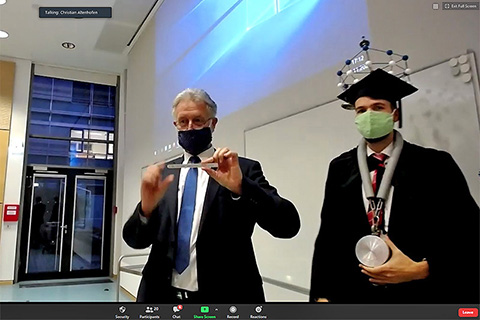Volumetric Subdivisions for Efficient Integrated Modeling and Simulation
We congratulate Christian Altenhofen on the successful defense of his PhD thesis "Volumetric Subdivisions for Efficient Integrated Modeling and Simulation"!

In his dissertation, Dr.-Ing. Altenhofen examines how subdivision volumes are advantageous for a closer integration of geometric modeling and physically based simulation. With a focus on Catmull-Clark (CC) solids, he presents new solutions in the areas of efficient limit evaluation, volumetric modeling, numerical integration and power quality analysis. In addition, he will present an efficient link to FEA as well as his IGA approach for CC solids, which improves the proof-of-concept of Burkhart et al. with time-constant limit evaluation, more accurate integration and higher power quality.
Dr.-Ing. Christian Altenhofen is member of the department "Interactive Engineering Technologies" at Fraunhofer IGD. The public defense of the dissertation with the topic "Volumetric Subdivisions for Efficient Integrated Modeling and Simulation" took place on November 5th at Fraunhofer IGD in Darmstadt. The thesis was supervised by Prof. Dr. techn. Dr.-Ing. eh. Dieter W. Fellner, Prof. Dr.-Ing. André Stork (both TU Darmstadt) and Assoc. Prof. M.Sc. PhD Ursula Augsdörfer (TU Graz).
Abstract
Continuous surface representations, such as B-spline and Non-Uniform Rational B-spline (NURBS) surfaces are the de facto standard for modeling 3D objects -- thin shells and solid objects alike -- in the field of Computer-Aided Design (CAD). For performing physically based simulation, Finite Element Analysis (FEA) has been the industry standard for many years. In order to analyze physical properties such as stability, aerodynamics, or heat dissipation, the continuous models are discretized into finite element (FE) meshes.
A tight integration of and a smooth transition between geometric design and physically based simulation are key factors for an efficient design and engineering workflow. Converting a CAD model from its continuous boundary representation (B-Rep) into a discrete volumetric representation for simulation is a time-consuming process that introduces approximation errors and often requires manual interaction by the engineer. Deriving design changes directly from the simulation results is especially difficult as the meshing process is irreversible.
Isogeometric Analysis (IGA) tries to overcome this meshing hurdle by using the same representation for describing the geometry and for performing the simulation. Most commonly, IGA is performed on bivariate and trivariate spline representations (B-spline or NURBS surfaces and volumes). While existing CAD B-Rep models can be used directly for simulating thin-shell objects, simulating solid objects requires a conversion from spline surfaces to spline volumes. As spline volumes need a trivariate tensor-product topology, complex 3D objects must be represented via trimming or by connecting multiple spline volumes, limiting the continuity to C0.
As an alternative to NURBS or B-splines, subdivision models allow for representing complex topologies with as a single entity, removing the need for trimming or tiling and potentially providing higher continuity.
While subdivision surfaces have shown promising results for designing and simulating shells, IGA on subdivision volumes remained mostly unexplored apart from the work of Burkhart et al. This is where Altenhofens research comes in.
 Fraunhofer Institute for Computer Graphics Research IGD
Fraunhofer Institute for Computer Graphics Research IGD